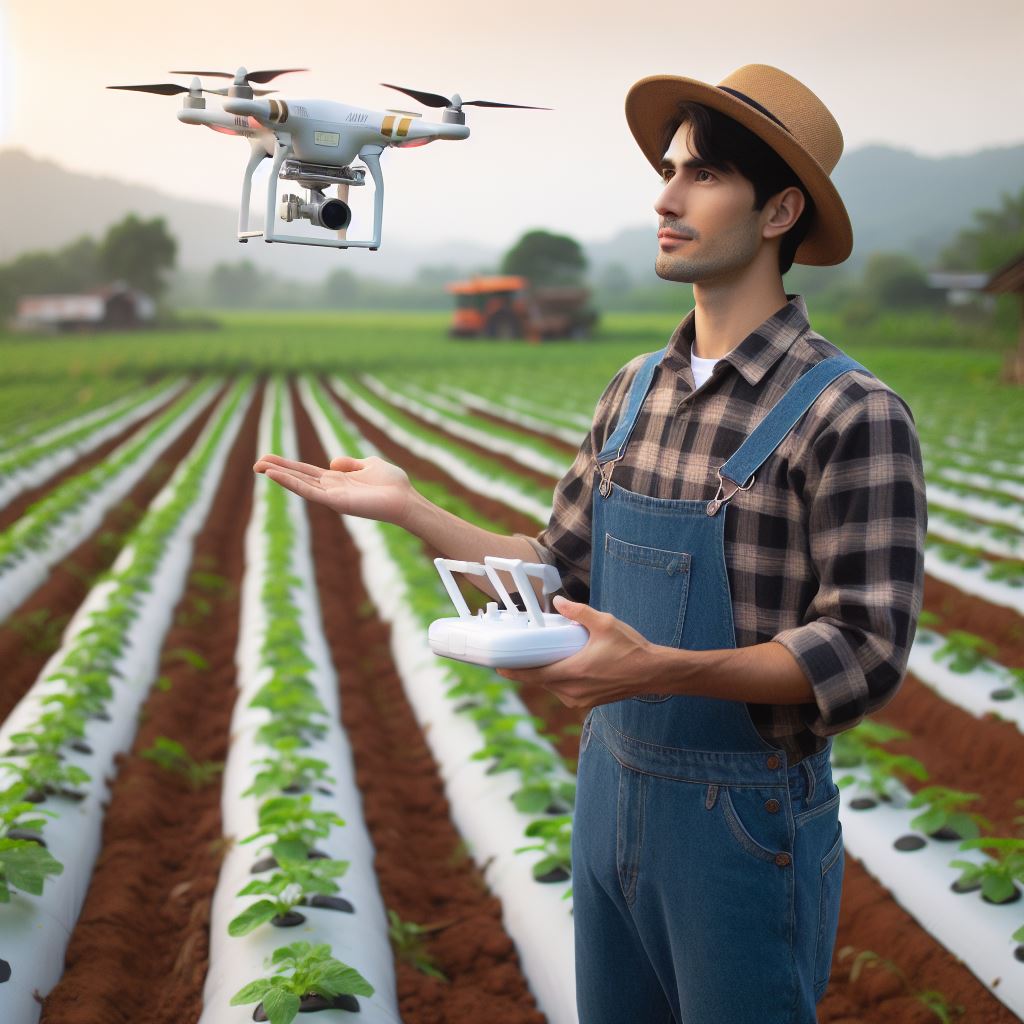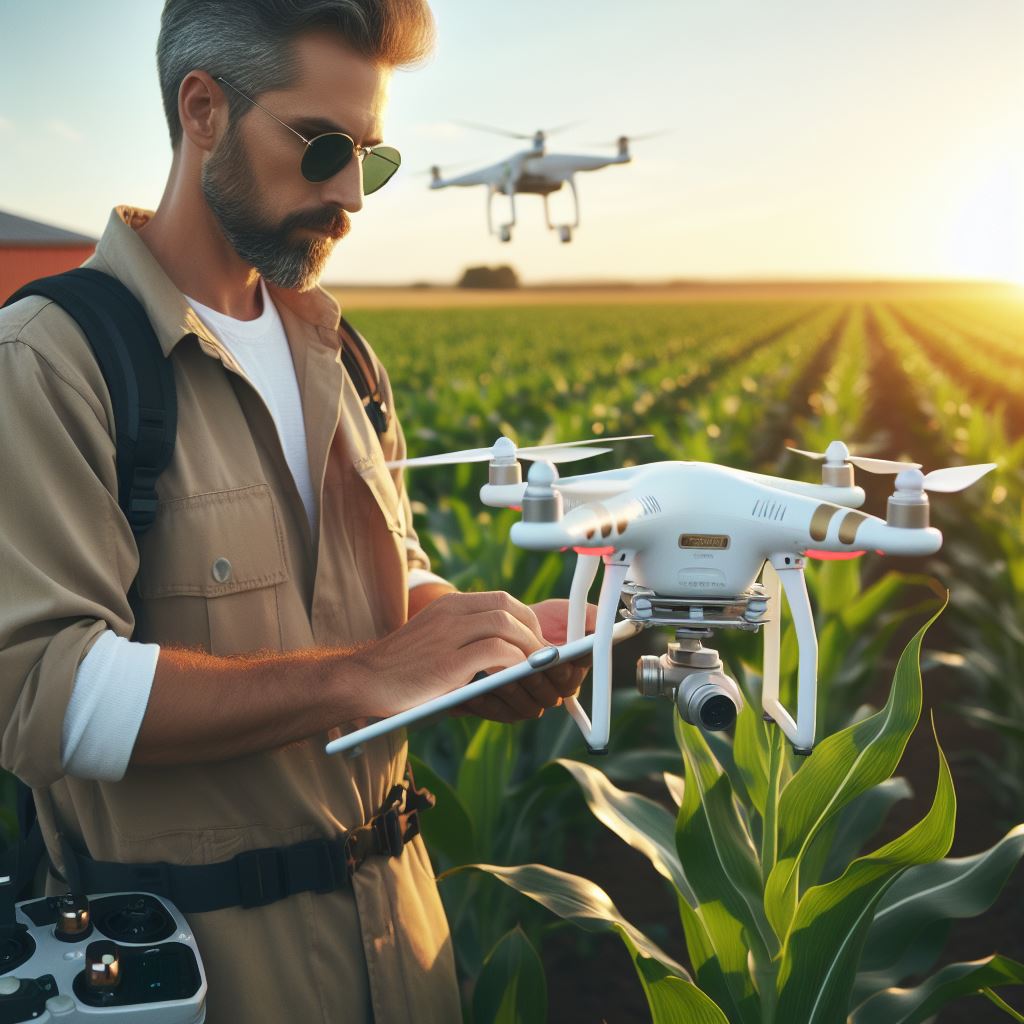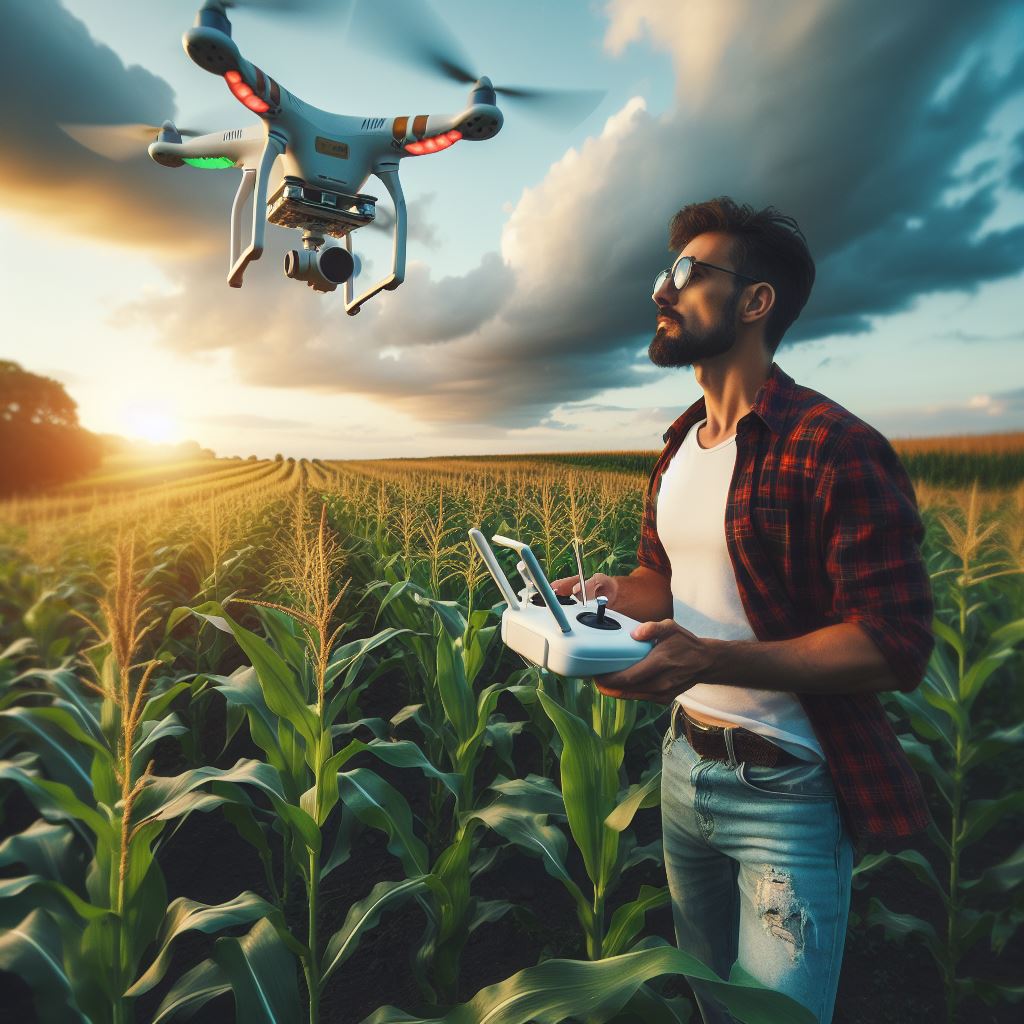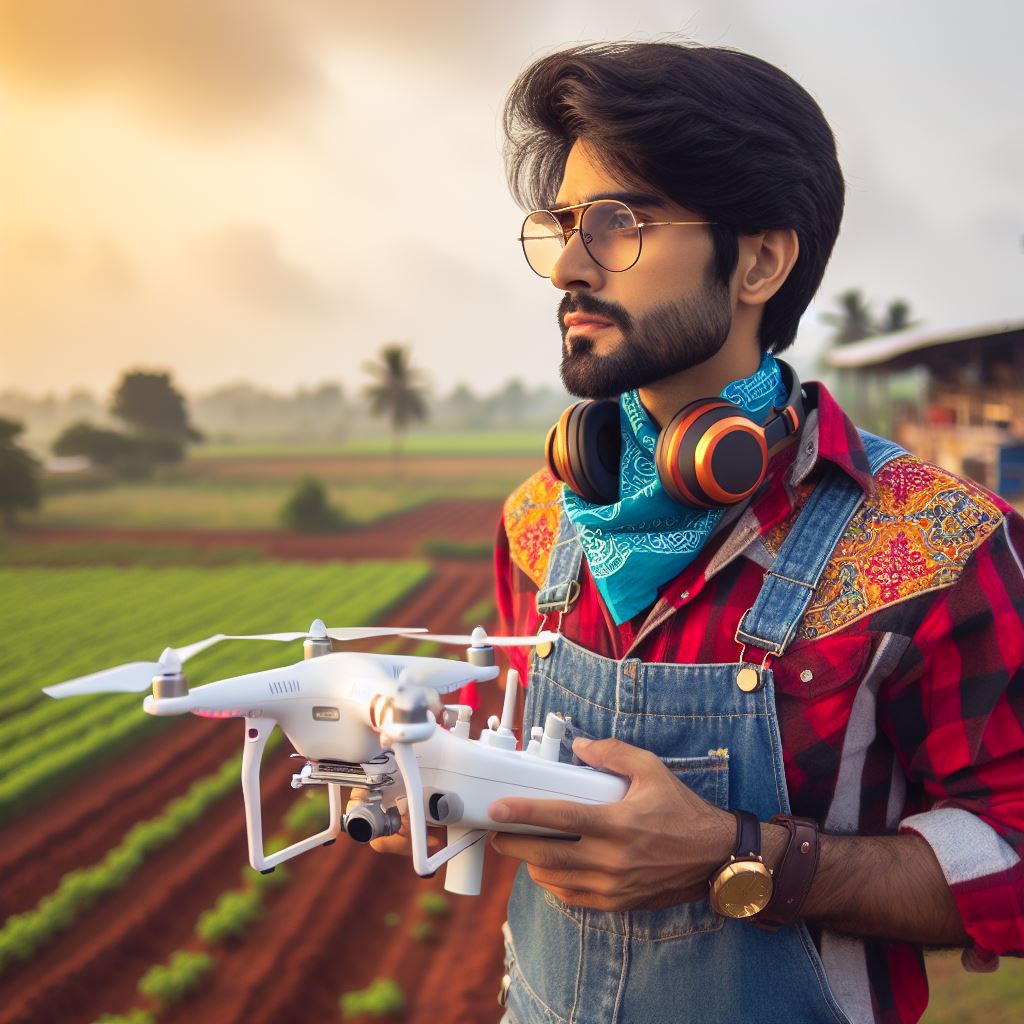Introduction
Brief explanation of precision agriculture
Precision agriculture leverages technology to optimize crops and resources.
It uses data and analytics to boost yields while minimizing inputs.
Drones are an ideal precision ag tool, providing aerial data to pinpoint field issues.
This post explores drones’ immense potential to revolutionize modern farming.
Importance of using technology in farming practices
Precision techniques profoundly impact agriculture.
Targeted inputs reduce costs and environmental impact.
The data empowers smarter decisions and efficient practices.
But the information needed for precision agriculture was difficult to gather before drones.
Drones can survey immense areas faster and more frequently than humans.
Their cameras and sensors gather valuable crop data unachievable manually.
Drones operate at low altitudes to provide fine-grained field insights. The regular flights enable consistent monitoring and rapid response.
Purpose of the blog post on drones in precision agriculture
This post discusses drones’ specialty cameras that reveal crop issues invisible to the naked eye.
It explores how drone data aids irrigation, fertilization, pest control, and more.
Real-world examples demonstrate drones enhancing productivity and sustainability.
We will examine future advancements on the horizon as drone precision ag becomes more capable and commonplace.
Transform Your Agribusiness
Unlock your farm's potential with expert advice tailored to your needs. Get actionable steps that drive real results.
Get StartedDrones are transforming agriculture by providing the data foundation for precision techniques.
Their adoption will only accelerate as drones prove vital for profitable, efficient farming.
This post provides a comprehensive look at drones’ capabilities and potential to revolutionize agriculture worldwide.
Let’s explore the emerging role of drones in precision farming and why they are a game changer.
What is precision agriculture?
Definition and concept
Precision agriculture is a farming approach that utilizes technology to optimize crop production and increase efficiency.
Key objectives and benefits
- Increased crop yield: Precision agriculture enables farmers to accurately manage their crops, leading to higher yields.
- Resource optimization: By using technology, farmers can minimize the use of water, pesticides, and fertilizers, reducing waste.
- Cost reduction: Precision agriculture helps farmers save money by minimizing input costs and maximizing output.
- Environmental sustainability: By using precise data and targeting specific areas, precision agriculture reduces the impact on the environment.
- Improved decision-making: Technology provides real-time data, helping farmers make informed decisions for better farming practices.
Role of technology in precision agriculture
- Drones: Drones have revolutionized precision agriculture by collecting aerial data, monitoring crops, and identifying issues before they escalate.
- GPS and GIS: Global Positioning Systems (GPS) and Geographic Information Systems (GIS) provide accurate location data for mapping fields and monitoring crop health.
- Sensors: Sensors gather data on soil moisture, temperature, and nutrient levels, allowing farmers to monitor and adjust their irrigation and fertilization practices.
- Remote sensing: It involves using satellite imagery and aerial photography to assess plant health, detect diseases, and manage irrigation.
- Data analytics: Advanced software and algorithms analyze the data collected, providing insights and predictions for efficient decision-making.
- Automation: Farm equipment can be integrated with technology, enabling automated tasks such as planting, harvesting, and spraying.
The integration of these technologies has transformed the agricultural sector, enhancing productivity and sustainability.
In short, precision agriculture, aided by the use of drones and other advanced technologies, is revolutionizing the farming industry.
With precise data and real-time monitoring, farmers can optimize their practices, increase crop yield, reduce costs, and minimize environmental impact.
This approach not only benefits farmers but also ensures a sustainable future for agriculture.
Read: Revolutionizing Farms: Drones in Crop Monitoring
Drones in Precision Agriculture
Introduction to Drones
Drones, also known as unmanned aerial vehicles (UAVs), have revolutionized the way agriculture is practiced.
Advantages of Using Drones in Farming
- Efficient Data Collection: Drones enable farmers to collect accurate and real-time data about their crops, soil conditions, and irrigation needs.
- Enhanced Crop Monitoring: With the help of drones, farmers can monitor their crops at any time to identify pest infestations, disease outbreaks, and nutrient deficiencies.
- Precision Spraying and Seed Dispersal: Drones equipped with spraying mechanisms can precisely target areas that require insecticides, fertilizers, or crop seeds, reducing wastage.
Types of Drones Used in Agriculture
- Fixed-wing Drones: Fixed-wing drones are efficient for covering large areas of farmland and can fly for extended periods of time.
- Multi-rotor Drones: Multi-rotor drones are more maneuverable and can hover over specific areas, enabling close-up inspections of crops.
- Hybrid Drones: Hybrid drones combine the features of both fixed-wing and multi-rotor drones, providing flexibility and longer flight times.
Regulations and Legal Considerations for Using Drones in Agriculture
When using drones in agriculture, farmers must adhere to specific regulations and legal considerations imposed by authorities.
- Farmers should obtain appropriate permits and licenses for operating drones in their respective regions.
- They must adhere to regulations regarding flight altitudes, no-fly zones, and privacy concerns.
- It is essential to ensure the safety of personnel and livestock while operating drones.
- Regular maintenance and inspection of drones should be performed to ensure their safe and efficient operation.
- Farmers must also be aware of weather conditions that may affect drone flights and plan accordingly.
Generally, drones have become indispensable tools in precision agriculture.
Their ability to collect data efficiently, monitor crops effectively, and perform precise spraying and seed dispersal contributes to increased yields and cost savings for farmers.
Transform Your Agribusiness Online Presence
Stand out with compelling content tailored to engage your audience and drive results. From blog posts to social media, we’ll create what your business needs to grow.
Get StartedWhile various types of drones are used in agriculture, farmers must comply with regulations and legal considerations to ensure the safe and responsible use of these technologies.
By embracing drones, farmers can optimize their agricultural practices and pave the way for a more sustainable and productive future.
Read: Drones in Agri: Irrigation Game Changer
Application of drones in precision agriculture
Drones have revolutionized the field of precision agriculture, transforming the way farmers monitor and manage their crops.
With their ability to capture high-resolution aerial images and collect data in real-time, drones have become essential tools in ensuring crop health and maximizing yields.
Crop health monitoring
Detection of diseases and pests
Drones equipped with specialized cameras and sensors can quickly identify crop diseases and pest infestations.
By capturing images of the fields from above, farmers can detect areas affected by diseases or pests, allowing for targeted treatments instead of blanket spraying of pesticides.
Identifying nutrient deficiencies
Through the use of multispectral imaging, drones can identify nutrient deficiencies in crops.
The drones capture images at various wavelengths, highlighting the different nutrient levels in the vegetation.
This information helps farmers apply fertilizers more efficiently, saving costs and minimizing environmental impacts.
Early detection of stress factors
Drones can detect crop stress factors such as water scarcity or temperature variations.
By monitoring the thermal signature of the fields, farmers can identify areas that need irrigation or implement measures to protect crops from extreme weather conditions, leading to better crop management and increased yield.
Field mapping and analysis
Soil moisture mapping
Drones equipped with advanced sensors can measure soil moisture levels across a field, providing farmers with valuable information for irrigation management.
By mapping soil moisture variations, farmers can optimize water usage, prevent over-irrigation, and reduce water wastage.
Unlock Farming Insights for Growth
Make smarter farming decisions with detailed reports on market trends, weather patterns, and soil health tailored to your farm's success. Boost productivity with actionable data.
Get ReportTopographic mapping
Drones can create accurate topographic maps of agricultural fields, identifying variations in elevation and slope.
This information helps farmers in land leveling and drainage planning, ensuring proper water flow and reducing the risk of soil erosion.
Yield mapping
Using specialized sensors, drones can collect data on crop yield variability within a field.
This information allows farmers to identify high-yield and low-yield areas, enabling targeted interventions to improve overall productivity and optimize resource allocation.
Precision spraying and seed dispersal
Targeted application of pesticides and fertilizers
Drones equipped with spraying systems can apply pesticides and fertilizers precisely to the areas that need treatment.
This targeted approach reduces chemical usage, minimizes environmental impacts, and ensures effective pest control and nutrient supplementation.
Improved accuracy in seed planting
By using drones for seed dispersal, farmers can achieve more precise and consistent seed placement, resulting in better germination rates and uniform crop growth.
This technique reduces seed wastage and promotes optimal plant density, leading to higher yields.
Animal monitoring and management
Livestock tracking and behavior analysis
Drones equipped with cameras and GPS technology can monitor the movement and behavior of livestock.
Farmers can remotely track their animals, ensuring their safety, identifying potential health issues, and optimizing herd management practices.
Monitoring pasture health and forage quality
Drones can capture aerial images of pastures, assessing the health and quality of the forage available to livestock.
Farmers can detect areas with inadequate grazing resources and make informed decisions regarding rotational grazing, ensuring optimal nutrition for their animals.
Essentially, drones have transformed precision agriculture by providing farmers with valuable tools for crop health monitoring, field mapping and analysis, precision spraying and seed dispersal, and animal monitoring and management.
With their ability to collect high-resolution data quickly and efficiently, drones are changing the game in agriculture, increasing yields, reducing costs, and promoting sustainable farming practices.
Read: Agri-Drones: Changing the Face of Farming
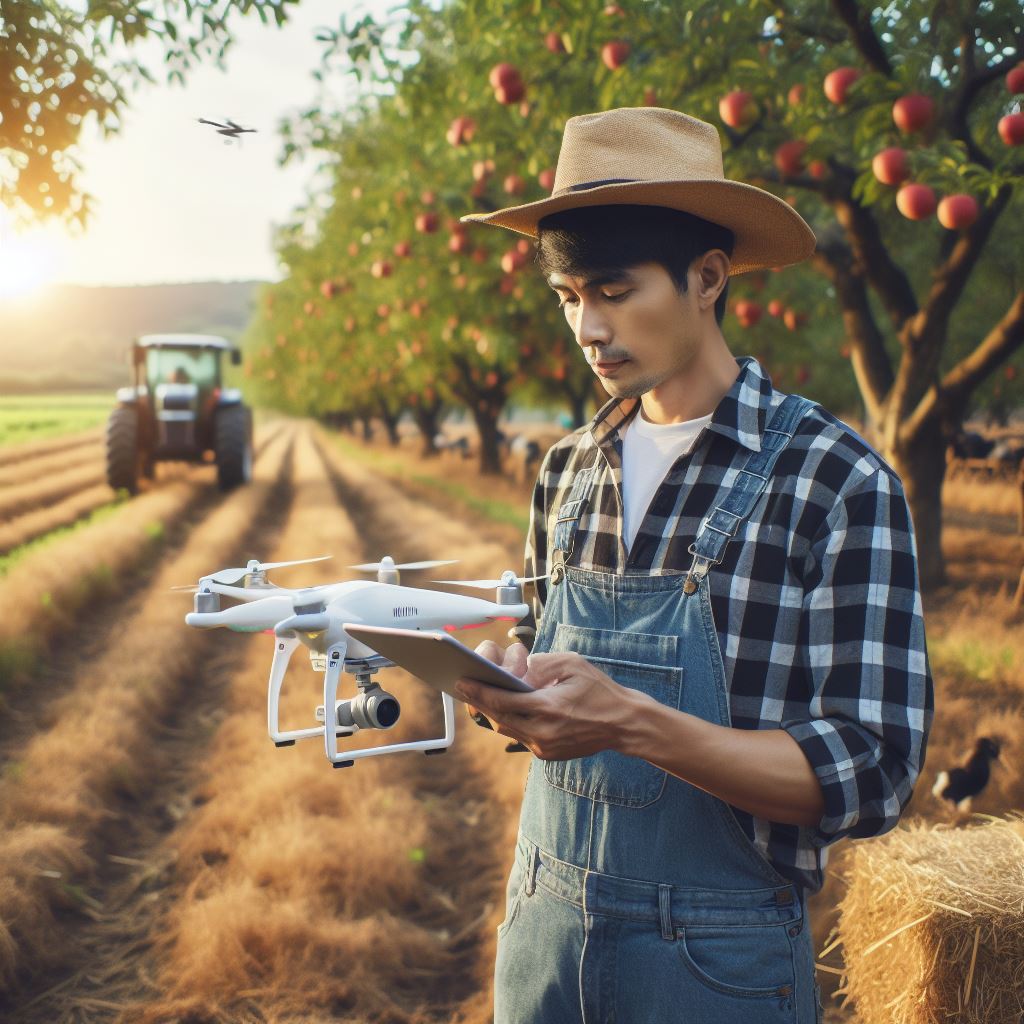
Challenges and limitations of using drones in precision agriculture
While the use of drones in precision agriculture brings numerous benefits, it also comes with its fair share of challenges and limitations.
In this section, we will discuss some of the key challenges that farmers and agronomists face when adopting drone technology.
High initial costs and investment
One of the major challenges of using drones in precision agriculture is the high initial costs involved.
Purchasing drones, along with necessary accessories and software, can be quite expensive for farmers, especially those with limited financial resources.
The cost of training personnel to operate and maintain drones also adds to the investment required.
Furthermore, the initial investment does not end with the purchase of drones.
Regular maintenance, repairs, and upgrades also incur additional costs.
For small-scale farmers, these high costs may act as a deterrent to adopting drone technology.
Technical limitations and system integration
Drones used in precision agriculture must overcome various technical limitations.
One significant challenge is the limited battery life of drones, which restricts their flight time and coverage area.
To overcome this, farmers often need to invest in multiple drones or have a well-established charging and swapping system in place.
In addition, drones may face challenges related to data storage and transmission.
The vast amount of data collected by drones needs to be efficiently managed, processed, and integrated with existing farm management systems.
This requires robust technical infrastructure and skilled personnel to handle the data effectively.
Training and personnel requirements
Operating drones in precision agriculture requires trained personnel who understand the technology and can handle its operations.
Training programs that teach farmers and agronomists how to effectively operate drones and analyze the collected data are essential.
A shortage of skilled personnel in rural areas can be a significant hurdle in the adoption of drone technology.
Establishing training centers and programs that cater to the specific needs of farmers can help overcome this challenge.
Privacy concerns and public perception
Another challenge faced by the use of drones in precision agriculture is related to privacy concerns and public perception.
Drones equipped with cameras and sensors can capture detailed images and data, raising concerns about data privacy and the potential invasion of personal space.
These concerns can lead to public resistance towards drones, especially in densely populated areas.
Addressing privacy concerns through transparent data collection practices and creating awareness about the benefits of drones in agriculture is crucial to gain public acceptance.
In general, while drones offer immense potential in revolutionizing precision agriculture, farmers and agronomists also encounter several challenges.
The high initial costs, technical limitations, training requirements, and privacy concerns must be carefully managed to ensure successful integration of drones in agricultural practices.
Read: Sky-High Agri Tech: Drone Spraying Explained
Future trends and developments
Advancements in drone technology for agriculture
- Improved battery life and flight time to cover larger areas in a single flight.
- Enhanced sensors and imaging capabilities for better crop monitoring and analysis.
- Integration of artificial intelligence for real-time decision-making and autonomous operations.
- Smaller and more agile drones for maneuvering through complex crop canopies.
- Development of robust communication systems for seamless data transfer and remote monitoring.
Integration with other precision agriculture tools
- Integration with satellite imagery and GPS technology for precise field mapping and navigation.
- Collaboration with sensor networks to collect data on soil moisture, temperature, and nutrient levels.
- Integration with agricultural machinery and smart irrigation systems for efficient resource management.
- Compatibility with data analytics software to derive actionable insights for farmers.
- Incorporation of weather monitoring systems to optimize farming operations based on real-time weather conditions.
Potential impact on farming practices and industry as a whole
- Increased efficiency and productivity by enabling timely monitoring and targeted interventions.
- Reduction in resource wastage through optimized use of fertilizers, pesticides, and water.
- Improved crop yield and quality by identifying stress factors at an early stage.
- Enhanced disease and pest management through early detection and localized treatment.
- Minimized labor costs and risks associated with manual operations in large farms.
- Accelerated shift towards sustainable farming practices by promoting precision agriculture.
- Potential for increased profitability and competitiveness in the agriculture industry.
In essence, the future of precision agriculture looks promising with continuous advancements in drone technology and their integration with other tools.
Farmers can expect improved efficiency, resource management, and crop yield through the use of drones.
The potential impact on the farming industry as a whole is significant, with the adoption of precision agriculture practices leading to sustainable farming and increased profitability.
As technology continues to evolve, the role of drones in agriculture is likely to expand further, revolutionizing farming practices and benefiting the global food production system.
Conclusion
The use of drones in precision agriculture is rapidly changing the game.
Throughout this blog post, we have explored the various ways in which drones are transforming farming practices.
We discussed how drones are enabling farmers to collect real-time data, monitor crop health, and identify areas that require attention.
Furthermore, drones help farmers optimize the use of resources such as water, fertilizers, and pesticides, leading to cost savings and environmental sustainability.
The importance of drones in revolutionizing precision agriculture cannot be understated.
By utilizing drones, farmers can increase crop yields, improve overall efficiency, and make more informed decisions.
These unmanned aerial vehicles have the potential to revolutionize farming practices and address the challenges of a growing global population and limited resources.
Therefore, it is crucial for farmers to explore the possibilities of incorporating drones into their agricultural operations.
By embracing this technology, farmers can stay ahead of the competition and ensure the long-term sustainability of their businesses.
In a nutshell drones are changing the game in precision agriculture by providing valuable insights, optimizing resources, and paving the way for a more sustainable farming future.

